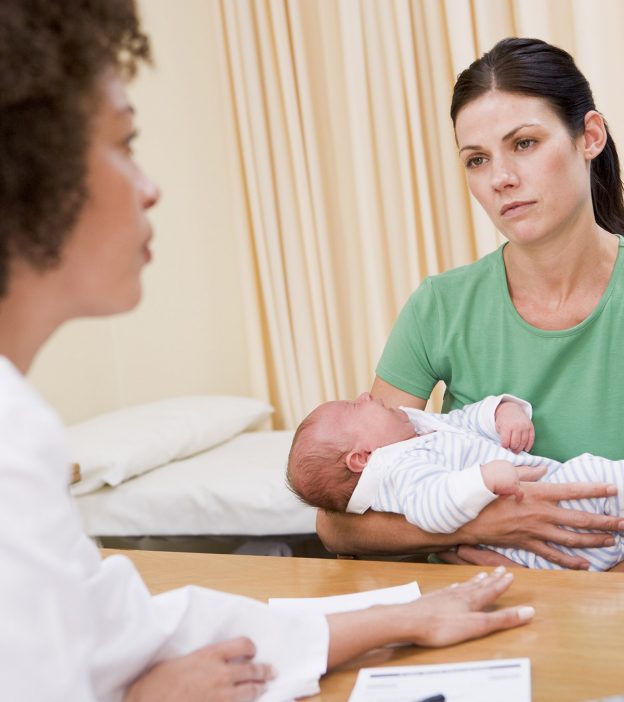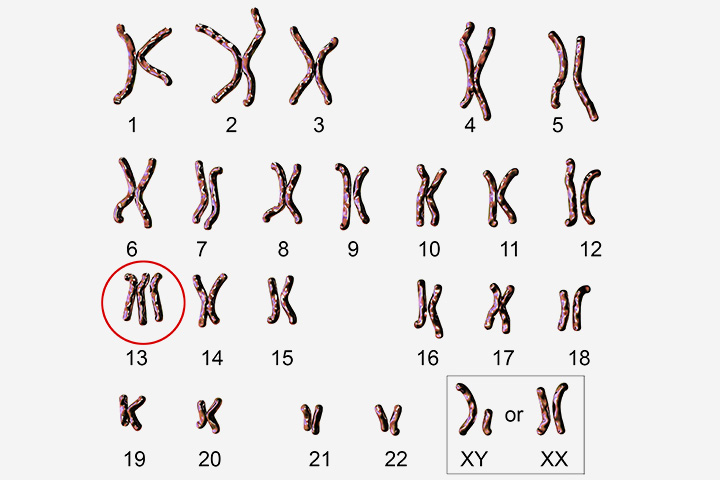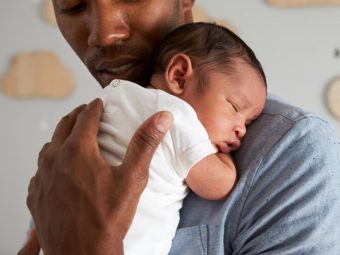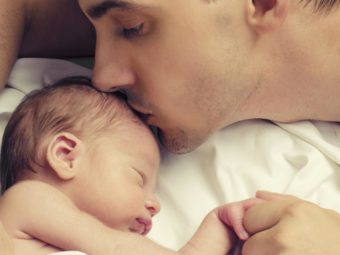
Image: ShutterStock
Pregnancy is a fragile period when your baby could be exposed to various medical conditions. But, certain structural abnormalities may be seen in babies with extra chromosomes due to genetic variability, which are usually detrimental and may cause complications in babies. A cell in the human body includes 46 chromosomes, with 23 each obtained from the mother and father. However, there could be an added or deleted chromosome in the developing fetus from either of the parents in certain cases. If you are unaware and curious about this genetic phenomenon, read this post to understand the possible causes, disorders, symptoms, and additional information on extra chromosomes in babies.
额外染色体出生的婴儿是什么意思?
Chromosomes are threadlike structures on which genes are placed like beads. An extra chromosome is the 47th chromosome in the human cells.This means that a baby with an extra chromosome will have 22 pairs plus three chromosomes (one from the mother and two from the father or vice versa)。这种情况被称为“三染色体性”——“三”的意思three and ‘somy’ means bodies.
The first 22 pairs of chromosomes, called autosomes, are identified with numbers from 1 to 22, with the longest pair being number 1. These determine the growth and functioning of the body.
The chromosomes in the last or 23rd pair are called the sex chromosomes and are named X and Y. If there are two X chromosomes in the 23rd pair, the baby is a female, and if there are X and Y chromosomes, the baby is a male.
The one extra chromosome can occur in any of the 22 autosomes or the single pair of sex chromosomes.
Causes For Extra Chromosome In Babies
An extra chromosome can happen in babies due to the below reasons:
- Abnormality in the division of sex cells (meiosis)
- Abnormality in the division of other cells (mitosis)
- Birth defect-causing substances (teratogens)
- Mother’s age
- Vitamin B deficiency
This chromosomal nondisjunction causes aneuploidy and polyploidy and results in producing abnormal numbers of chromosomes in babies.
1. Abnormality In Meiosis:
The sex cells in males and females divide to create sperm and egg respectively. The division process is called meiosis and occurs in two phases, namely first meiotic division and second meiotic division. Unlike other cells, the egg and sperm only have 23 chromosomes each (i.e. they don’t have “pairs of chromosomes”). Thus, an egg has 22 autosomes and one sex chromosome X. Sperm, too, has 22 autosomes and one sex chromosome (X or Y).
When fertilization takes place, the 23 chromosomes in egg and sperm unite to form 46 chromosomes in the fetus.
Anomalies in the meiosis process may result in 47 chromosomes。They can also result in only 45 chromosomes, one less than the normal. This condition is called monosomy.
2. Abnormality In Mitosis:
Mitosis is the division of cells other than the egg and sperm. In this process, the 46 chromosomes double into 92 and then divide into half. It happens after the fertilization and as thefetus growsin the womb. In fact, mitosis is a continuous process throughout the baby’s life as it keeps replacing dead and dysfunctional cells.
There can be an error in the process of mitosis during pregnancy, leading to one more or one less chromosome.
3. Teratogens:
Teratogens are external substances that a woman can get exposed to during her pregnancy. The below elements can result in trisomy (1):
- Certain medicines
- Drugs
- Alcohol
- Tobacco
- Toxic chemicals
- Viruses and bacteria
- Radiation
- Health conditions such as diabetes
4. Mother’s age:
婴儿高于35岁妇女有你好gher risk of trisomy。The eggs age as the woman grows older (2). Some scientists believe that as the eggs get older, they are likely to have an incorrect number of chromosomes, resulting in abnormalities during fertilization.
5. Vitamin B Deficiency:
It is known that vitamin B folic acid deficiency leads toneural tube deficienciesiXBirth malformations affecting the brain, spine, or spinal cord that occur in the first month of pregnancy。Researchers are gathering evidence that folic acid also influences chromosome formation. Women with low levels of this vitamin could be at a higher risk of having babies with extra chromosome disorders. However, this is yet to be proven.
Meanwhile, researchers at the University of California, Berkeley, and the Lawrence Berkeley National Laboratory, have found that lower levels of folate in males could lead to abnormal chromosomes in their offspring。(3)
Suzanne Young, a researcher at UC Berkeley’s School of Public Health says: “Our study is the first to look at the effects of diet on chromosomal abnormalities in sperm. These abnormalities would cause either miscarriages or children with genetic syndromes if the sperm fertilized an egg.”
What Happens When A Baby Has An Extra Chromosome or Trisomy?
Most cases of trisomy end up in miscarriage or stillborn babies.Analyses have found that more than 60% of first trimester miscarriages and 5 to 10% of stillborn cases were due to chromosomal abnormalities。
Even if the baby survives, their life span could be short and filled with several developmental problems. Here are a few conditions that a child with extra chromosomes could have:
1. Trisomy 21 – Down Syndrome:
Trisomy 21, named as the chromosome number 21 has the abnormality, is one of the most common consequences of an extra chromosome. In 90% of the cases, the extra chromosome comes from the mother’s egg rather than from the father’s sperm.
Down syndrome is of three types:
- Standard Trisomy 21:The sperm or egg cell contains the extra chromosome.
- Mosaic Down syndrome:The extra chromosome comes up as the fetus develops.
- Translocation Down syndrome:This is a result of inheritance due to some chromosomal rearrangement in parents.
A child with Down syndrome has birth defects such as lower mental growth, abnormal facial features, heart defects, and others.
2. Trisomy 18 – Edward Syndrome:
Trisomy 18 is a chromosomal syndrome associated with body abnormalities. It’s also called Edwards syndrome, named after the doctor who first analyzed it. Studies show that only 50% of babies with trisomy 18, who are carried to term, are born alive. The survival rate is higher among girls than boys. (4)
In Trisomy 18, the baby has three copies of chromosome 18.
Edward syndrome also can be one of the three:
- Full Trisomy 18:This is the most common trisomy 18, wherein the extra chromosome is there in every cell of the baby’s body.
- Mosaic Trisomy 18:The extra chromosome is present in a few cells of the baby. This is a rare form of trisomy 18.
- Translocation Trisomy 18:Translocation happens when a chromosome gets attached to another. Babies can have this condition due to inheritance if one of their parents has an attached chromosome.
The condition leads to defects in various vital organs such as kidneys and heart,cleft lipiXA separation in the upper lip of a baby caused due to improper development of the fetus during early pregnancy, small skull, neural tube defects, and malformation of sex organs, hands, and legs.
Babies with Edward syndrome are thin, their head size is small, have seizures, and their growth is slow.
3. Trisomy 13 – Patau Syndrome:
This condition results in: (5)
- Small skull or microcephaly
- An abnormal opening in the skull
- Malformations of the brain and sex organs
- Structural defects of the eyes
- Cleft lip or cleft palate
- Extra toes or fingers (polydactyly)
- Congenital heart disorders
- Neural tube defects
Babies with Trisomy 18 or 13 do not usually survive beyond the neonatal stage; 20 to 30% die in the first month, and 90% by the time they complete one year. Very few of them can survive into their teenage years.
Symptoms Of Trisomy During Pregnancy
Your doctor could look out for these signs during your pregnancy, to detect chromosomal abnormalities. They are visible in ultrasound scans.
- High quantity ofamniotic fluidsurrounds the baby (polyhydramnios).
- There is only one umbilical cord artery.
- Asmaller placenta
- The fetus does not grow by itsgestational ageiXA term used to describe the stage of pregnancy after a woman’s last menstrual period。
- The baby’s movements are not as frequent as they need to be.
Diagnosis Of Trisomy Disorders In Babies
Trisomy disorders may be diagnosed using one or more of these methods:
- Ultrasound scans
- Maternal serum screening and carrier screening
- Amniocentesis test is performed with a sample ofamniotic fluidiXA protective clear, yellowish liquid surrounding the fetus throughout pregnancy in the amniotic sac
- Chorionic villi samplingiXA genetic test that examines cells from the placenta to determine a genetic or chromosomal issue in the unborn baby(CVS) is done by taking a sample of cells from the chorion tissue.
- 非侵入性产前测试执行(NIPT)on the fetus’ DNA.
- A blood test is done during the first andsecond trimesters。
- In addition to the blood test, a special ultrasound may be needed during thefirst trimesterto study the back of the baby’s neck.
- Babies’ blood is tested using karyotype analysis after they are born.
- Pregnant women above the age of 35 years are recommended to opt for genetic counseling and amniocentesis.
 Quick fact
Quick factFrequently Asked Questions
1. What are the disorders due to extra sex chromosomes?
Extra sex chromosomes are less harmful than the above cases of trisomies. An additional sex chromosome will lead to the following disorders:
Klinefelter syndrome:
Klinefelter syndrome is caused if the babies have XXY or XXXY sex chromosomes. This condition, which is usually not known until the boys reach the age of puberty, leads to infertility, shorter testicles, and development of breasts. Sometimes, it could also slow down mental growth.
If the boy is low in testosterone levels, he can be administered the hormone through injections, but the treatment is done only after he is a teenager.
XYY syndrome:
Boys with XYY syndrome can lead a normal life. Sometimes the abnormality goes undetected. Also called XYY Karyotype or Jacob’s syndrome, the disorder occurs in about one in every 1,000 newborn boys. (6)
Triple X syndrome:
Triple X syndrome affects only girls as they have three X chromosomes. Some girls could have learning disabilities or lower mental growth. They may grow tall, have a small head, and be infertile. However, in some girls, the defect could be undetected as they lead a normal life.
2. How does the mother’s age increase the chances of Down syndrome in babies?
The chances of Down syndrome increase with the age of the mother. According to the American College of Obstetricians and Gynecologists, the risk of Down syndrome at a specific age of the mother is:
- 1 in 1,000 at age 30
- 1 in 353 at age 35
- 1 in 85 at age 40
3. Are all children with the same chromosomal abnormality alike?
Children with the same chromosomal abnormalities are not necessarily alike. They differ because the body’s reaction to the syndrome depends on the gene setup, which is unique. The hundreds of genes in each chromosome influence the body’s behavior to the abnormality.
This makes it more difficult for the doctors to predict the future symptoms in a baby with chromosomal disorder. Latest technologies can sometimes help the experts identify the behavior of genes and get a better picture of the symptoms.
4. Will the siblings of a child with chromosomal abnormality have the same problem?
It is not necessary that the subsequent siblings of an abnormal child would have the same problem as abnormalities in chromosomal mutations are thought to be random and accidental. Translocation chromosomal abnormalities could be hereditary, passing on from the parent to the child.
Parents of abnormal children need to undergo consultation to rule out any possibilities of abnormality in their subsequent children.
5. What is chromosome 22 or trisomy mosaic?
Chromosome 22 is a rare condition where the baby has an extra chromosome 22 in some cells of the body, while other cells are normal. It affects girls more than boys (7). Symptoms of the condition include growth delays, low mental growth, unsymmetrical development of the two sides of the body (hemidystrophy), and webbing of the neck.
6. What is Isodicentric chromosome 15 syndrome?
Isodicentric chromosome 15 syndrome is a developmental disorder with symptoms including poor muscle tone, developmental delays, weak facial muscles, intellectual disability, and strabismus (eyes that do not look at the same direction) (8)
Abnormal cell division due to various genetic inheritance and environmental factors can cause chromosomal duplication in babies. Environmental factors such as exposure to teratogens, deficiency of folate, and advanced maternal age are common causes of abnormal cell division during development. Down syndrome, Edward syndrome, and Patau syndrome are some of the genetic disorders caused by extra genetic material on specific chromosomes. There can also be extra sex chromosomes leading to disorders such as Klinefelter syndrome. Chromosomal anomalies and genomic imbalance may trigger miscarriage, and many pregnancies are not carried to term.
Infographic: Signs Of Trisomy During Pregnancy
Trisomy during pregnancy is detectable through a scan performed on your doctor’s advice. During the scan, the doctor may look for specific signs highlighted in this infographic. However, note that these signs do not necessarily mean that your baby will have trisomy; speak to your doctor about confirming the condition with precise tests.

Illustration: Momjunction Design Team
Get high-quality PDF version by clicking below.
Download Infographic
Key Takeaways
- Trisomy is when a baby has 22 pairs of chromosomes plus an extra chromosome.
- Trisomy can be caused by abnormal cell division, birth-defect-causing substances, maternal age, or Vitamin B deficiency.
- An extra chromosome can cause conditions like Down, Edwards, or Patau syndrome.
- Symptoms of trisomy can be detected through ultrasound scans.
- Trisomy is detected if there is high amniotic fluid, one umbilical cord artery, a smaller placenta, delayed fetal growth, or reduced movements.
References:
- Medical Genetics: How Chromosome Abnormalities Happen.
https://www.urmc.rochester.edu/encyclopedia/content.aspx?ContentTypeID=90&ContentID=P02126 - How chromosome abnormalities happen.
https://childrenswi.org/medical-care/genetics-and-genomics-program/medical-genetics/chromosome-abnormalities/how-chromosome-abnormalities-happen - Folate intake linked to genetic abnormalities in sperm, says new study.
https://www.berkeley.edu/news/media/releases/2008/03/19_folatesperm.shtml - What is Trisomy-18?
https://www.trisomy18.org/what-is-trisomy-18/ - Trisomy Disorders.
https://www.betterhealth.vic.gov.au/health/conditionsandtreatments/trisomy-disorders - Chromosomal problems in newborn babies
https://www.aboutkidshealth.ca/Article?contentid=468&language=English - Mosaic Trisomy 22.
https://rarediseases.org/rare-diseases/chromosome-22-trisomy-mosaic/ - Chromosome 15.
https://medlineplus.gov/genetics/chromosome/15/#conditions - Trisomy 21 (Down Syndrome).
https://www.chop.edu/conditions-diseases/trisomy-21-down-syndrome




















